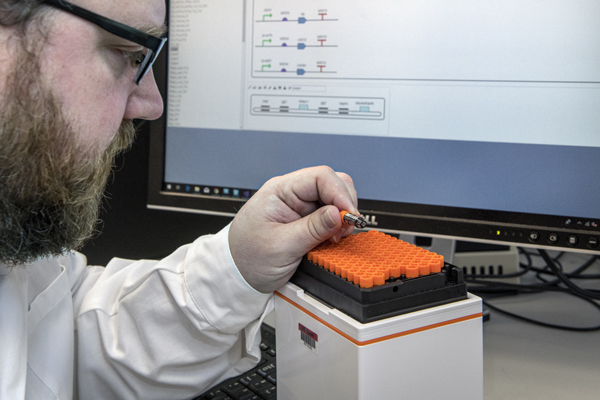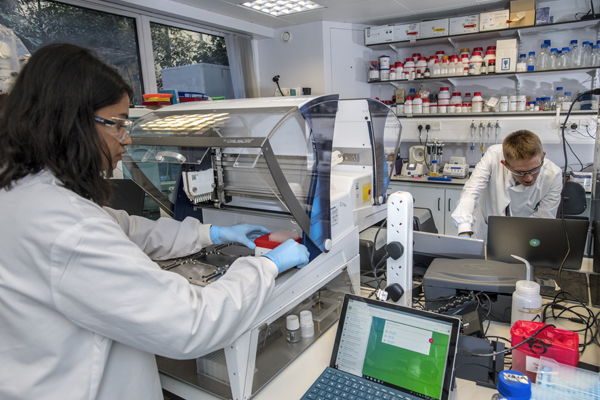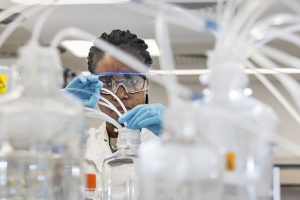Our work on the Station B project has now been retired. We continue to actively explore the exciting intersection of computing and life sciences, with other projects located on www.microsoft.com/research.
Building a platform for programming biology
The ability to program biology could enable fundamental breakthroughs across a broad range of industries, including medicine (opens in new tab), agriculture (opens in new tab), food (opens in new tab), construction (opens in new tab), textiles (opens in new tab), materials (opens in new tab) and chemicals (opens in new tab). It could also help lay the foundation for a future bioeconomy (opens in new tab) based on sustainable technology. Despite this tremendous potential, programming biology today is still done largely by trial-and-error. To tackle this challenge, the field of synthetic biology (opens in new tab) has been working collectively for almost two decades to develop new methods and technology for programming biology. Station B is part of this broader effort, with a focus on developing an integrated platform that enables selected partners to improve productivity within their own organisations, in line with Microsoft’s core mission. The Station B project builds on over a decade of research at Microsoft on understanding and programming information processing in biological systems, in collaboration with several leading universities. The name Station B is directly inspired by Station Q (opens in new tab), which launched Microsoft’s efforts in quantum computing, but focuses instead on biological computing.
The Station B platform is being developed at Microsoft Research in Cambridge, UK, which houses Microsoft’s first molecular biology laboratory. The platform aims to improve all phases of the Design-Build-Test-Learn workflow typically used for programming biological systems:
- The Design phase will incorporate biological programming languages that operate at the molecular, genetic and network levels. These languages can in turn be compiled to a hierarchy of biological abstractions, each with their associated analysis methods, where different abstractions can be selected depending on the biological question being addressed. For example, a Continuous Time Markov Chain can be used to determine how random noise affects system function, using stochastic simulation or probabilistic model-checking methods.
- The Build phase will incorporate compilers that translate high-level programs to DNA code, together with a digital encoding of the biological experiments to be performed.
- The Test phase will execute biological experiments using lab robots in collaboration with technology partner Synthace (opens in new tab), by using their award-winning Antha (opens in new tab) software, a powerful software platform built on Azure Internet of Things (opens in new tab) that gives biologists sophisticated control over lab hardware.
- The Learn phase will incorporate a range of methods for extracting biological knowledge from experimental data, including Bayesian inference, symbolic reasoning and deep learning methods, running at scale on Azure (opens in new tab).
These phases will be integrated with a biological knowledge base that stores computational models representing the current understanding of the biological systems under consideration. As new experiments are performed, the knowledge base will be updated via automated learning.

Cambridge (UK) houses Microsoft’s first wet lab, where the Station B team is developing its end-to-end system. Photo by Jonathan Banks.
Partnering for transformation
Station B is a collaborative effort being carried out with selected technology, academic and commercial partners.
Technology partner Synthace (opens in new tab) provides a key abstraction layer for the digital encoding of biological experiments. Their Antha software allows the same digitally encoded experiment to be executed by a range of lab automation devices made by different manufacturers, much like printer drivers allow the same PDF to be printed by any make or model of printer. This ability to run experiments in the same way each time gives users higher confidence in their results. Antha aims to tackle the reproducibility crisis (opens in new tab) in biological experiments by digitally encoding all aspects of the experiment in a systematic fashion. It also allows substantial scaling up of experiments. This automated generation of reproducible experimental data at scale is a key requirement for machine learning, allowing users to pose and learn from much more sophisticated lines of inquiry.

Synthace’s lab automation platform allow users to run experiments from the cloud and precisely replicate each step in complicated scientific protocols. Photo by Jonathan Banks.

Oxford Biomedica is pioneering gene therapies and is working with the Station B team to apply modeling and machine learning to improve its experimental and production processes. Photo by Jonathan Banks.
Princeton University (opens in new tab) are the first academic partners for Station B (opens in new tab). The focus of the partnership will be to develop and apply the Station B platform to understand the formation of biofilms – surface associated colonies of bacteria that kill as many people as cancer and play a key role in antibiotic resistance, recognised by the world health organisation as a global crisis. The partnership will involve a collaboration with Prof. Bonnie Bassler (opens in new tab), a world-leading microbiologist and chair of Princeton’s Department of Molecular Biology (opens in new tab). The Princeton team also includes Bassler’s longtime collaborator Prof. Ned Wingreen (opens in new tab), a physicist in Princeton’s Lewis-Sigler Institute for Integrative Genomics (opens in new tab). The Station B platform will be deployed in the Bassler lab to construct and test different versions of proteins that are key to biofilm formation, and to build on their extensive inventory of genetic components, models and experimental data collected over many years of studying bacterial biofilms.
Oxford Biomedica (opens in new tab) are the first commercial partners for Station B and are a leading cell and gene therapy company. They secured a deal (opens in new tab) with Novartis to produce the first treatment approved in the U.S. and the E.U. that reprograms a patient’s own immune cells (opens in new tab) to recognize and kill cancer cells in patients with leukemia and lymphoma. The drug must be specially made for each individual and costs nearly half a million dollars to treat a child with acute lymphoblastic leukemia. Before the treatment, those children typically had weeks or months to live. After receiving the cell therapy, 81 percent (opens in new tab) of the children in clinical trials went into remission. The initial goal of the partnership will be to apply the modeling and machine learning expertise developed at Station B to improve both the production yield and quality of therapies, in order to reduce overall costs and facilitate the future production of new therapies.

